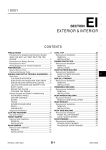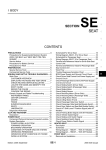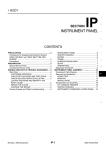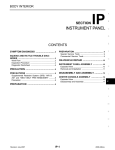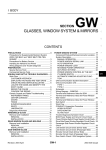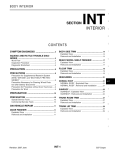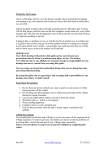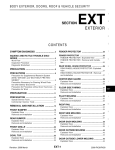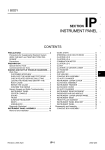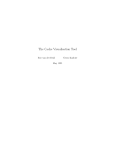Download IP - MyZRoadster
Transcript
INSTRUMENT PANEL I BODY SECTION IP INSTRUMENT PANEL A B C D E CONTENTS PRECAUTIONS .......................................................... 2 Precautions for Supplemental Restraint System (SRS) “AIR BAG” and “SEAT BELT PRE-TENSIONER” .................................................................. 2 Precautions for Battery Service ................................ 2 Precautions .............................................................. 2 PREPARATION ........................................................... 3 Special Service Tools ............................................... 3 Commercial Service Tools ........................................ 3 SQUEAK AND RATTLE TROUBLE DIAGNOSES..... 4 Work Flow ................................................................ 4 CUSTOMER INTERVIEW ..................................... 4 DUPLICATE THE NOISE AND TEST DRIVE ....... 5 CHECK RELATED SERVICE BULLETINS ........... 5 LOCATE THE NOISE AND IDENTIFY THE ROOT CAUSE ...................................................... 5 REPAIR THE CAUSE ........................................... 5 CONFIRM THE REPAIR ....................................... 6 Generic Squeak and Rattle Troubleshooting ............ 6 INSTRUMENT PANEL .......................................... 6 CENTER CONSOLE ............................................. 6 DOORS ................................................................. 6 TRUNK .................................................................. 7 SUNROOF/HEADLINING ..................................... 7 SEATS ................................................................... 7 UNDERHOOD ....................................................... 7 Diagnostic Worksheet ............................................... 8 INSTRUMENT PANEL ASSEMBLY ......................... 10 Component Parts Drawing ..................................... 10 Removal and Installation ........................................ 11 WORK STEP ....................................................... 11 REMOVAL ........................................................... 12 INSTALLATION ................................................... 15 Disassembly and Assembly .................................... 16 CENTER CONSOLE ........................................... 16 CLUSTER LID C ................................................. 17 F G H IP J K L M Revision: 2005 August IP-1 2006 350Z PRECAUTIONS PRECAUTIONS PFP:00001 Precautions for Supplemental Restraint System (SRS) “AIR BAG” and “SEAT BELT PRE-TENSIONER” NIS00090 The Supplemental Restraint System such as “AIR BAG” and “SEAT BELT PRE-TENSIONER”, used along with a front seat belt, helps to reduce the risk or severity of injury to the driver and front passenger for certain types of collision. This system includes seat belt switch inputs and dual stage front air bag modules. The SRS system uses the seat belt switches to determine the front air bag deployment, and may only deploy one front air bag, depending on the severity of a collision and whether the front occupants are belted or unbelted. Information necessary to service the system safely is included in the SRS and SB section of this Service Manual. WARNING: ● To avoid rendering the SRS inoperative, which could increase the risk of personal injury or death in the event of a collision which would result in air bag inflation, all maintenance must be performed by an authorized NISSAN/INFINITI dealer. ● Improper maintenance, including incorrect removal and installation of the SRS, can lead to personal injury caused by unintentional activation of the system. For removal of Spiral Cable and Air Bag Module, see the SRS section. ● Do not use electrical test equipment on any circuit related to the SRS unless instructed to in this Service Manual. SRS wiring harnesses can be identified by yellow and/or orange harnesses or harness connectors. Precautions for Battery Service NIS00091 Before disconnecting the battery, lower both the driver and passenger windows. This will prevent any interference between the window edge and the vehicle when the door is opened/closed. During normal operation, the window slightly raises and lowers automatically to prevent any window to vehicle interference. The automatic window function will not work with the battery disconnected. Precautions NIS00092 Disconnect both battery cables in advance. ● Disconnect air bag system line in advance. ● Never tamper with or force air bag lid open, as this may adversely affect air bag performance. ● Be careful not to scratch pad and other parts. ● When removing or disassembling any part, be careful not to damage or deform it. Protect parts, which may get in the way with cloth. ● When removing parts with a screwdriver or other tool, protect parts by wrapping them with vinyl or tape. ● Keep removed parts protected with cloth. ● If a clip is deformed or damaged, replace it. ● If an unreusable part is removed, replace it with a new one. ● Tighten bolts and nuts firmly to the specified torque. ● After re-assembly has been completed, make sure each part functions correctly. ● Remove stains in the following way. Water-soluble stains: Dip a soft cloth in warm water, and then squeeze it tightly. After wiping the stain, wipe with a soft dry cloth. Oil stain: Dissolve a synthetic detergent in warm water (density of 2 to 3% or less), dip the cloth, then clean off the stain with the cloth. Next, dip the cloth in fresh water and squeeze it tightly. Then clean off the detergent completely. Then wipe the area with a soft dry cloth. ● Do not use any organic solvent, such as thinner or benzine. ● Revision: 2005 August IP-2 2006 350Z PREPARATION PREPARATION Special Service Tools PFP:00002 A NIS00093 The actual shapes of Kent-Moore tools may differ from those of special service tools illustrated here. B Tool number (Kent-Moore No.) Tool name Description C (J39570) Chassis ear D Locating the noise E SIIA0993E (J43980) NISSAN Squeak and Rattle Kit F Repairing the cause of noise G SIIA0994E Commercial Service Tools NIS00094 H Tool name Description IP Engine ear Locating the noise J SIIA0995E K L M Revision: 2005 August IP-3 2006 350Z SQUEAK AND RATTLE TROUBLE DIAGNOSES SQUEAK AND RATTLE TROUBLE DIAGNOSES Work Flow PFP:00000 NIS00095 SBT842 CUSTOMER INTERVIEW Interview the customer if possible, to determine the conditions that exist when the noise occurs. Use the Diagnostic Worksheet during the interview to document the facts and conditions when the noise occurs and any customer's comments; refer to IP-8, "Diagnostic Worksheet" . This information is necessary to duplicate the conditions that exist when the noise occurs. ● The customer may not be able to provide a detailed description or the location of the noise. Attempt to obtain all the facts and conditions that exist when the noise occurs (or does not occur). ● If there is more than one noise in the vehicle, be sure to diagnose and repair the noise that the customer is concerned about. This can be accomplished by test driving the vehicle with the customer. ● After identifying the type of noise, isolate the noise in terms of its characteristics. The noise characteristics are provided so the customer, service adviser and technician are all speaking the same language when defining the noise. ● Squeak —(Like tennis shoes on a clean floor) Squeak characteristics include the light contact/fast movement/brought on by road conditions/hard surfaces=higher pitch noise/softer surfaces=lower pitch noises/edge to surface=chirping ● Creak—(Like walking on an old wooden floor) Creak characteristics include firm contact/slow movement/twisting with a rotational movement/pitch dependent on materials/often brought on by activity. ● Rattle—(Like shaking a baby rattle) Rattle characteristics include the fast repeated contact/vibration or similar movement/loose parts/missing clip or fastener/incorrect clearance. ● Knock —(Like a knock on a door) Knock characteristics include hollow sounding/sometimes repeating/often brought on by driver action. ● Tick—(Like a clock second hand) Tick characteristics include gentle contacting of light materials/loose components/can be caused by driver action or road conditions. ● Thump—(Heavy, muffled knock noise) Thump characteristics include softer knock/dead sound often brought on by activity. ● Buzz—(Like a bumble bee) Buzz characteristics include high frequency rattle/firm contact. ● Often the degree of acceptable noise level will vary depending upon the person. A noise that you may judge as acceptable may be very irritating to the customer. ● Weather conditions, especially humidity and temperature, may have a great effect on noise level. Revision: 2005 August IP-4 2006 350Z SQUEAK AND RATTLE TROUBLE DIAGNOSES DUPLICATE THE NOISE AND TEST DRIVE If possible, drive the vehicle with the customer until the noise is duplicated. Note any additional information on the Diagnostic Worksheet regarding the conditions or location of the noise. This information can be used to duplicate the same conditions when you confirm the repair. If the noise can be duplicated easily during the test drive, to help identify the source of the noise, try to duplicate the noise with the vehicle stopped by doing one or all of the following: 1) Close a door. 2) Tap or push/pull around the area where the noise appears to be coming from. 3) Rev the engine. 4) Use a floor jack to recreate vehicle “twist”. 5) At idle, apply engine load (electrical load, half-clutch on M/T models, drive position on A/T models). 6) Raise the vehicle on a hoist and hit a tire with a rubber hammer. ● Drive the vehicle and attempt to duplicate the conditions the customer states exist when the noise occurs. ● If it is difficult to duplicate the noise, drive the vehicle slowly on an undulating or rough road to stress the vehicle body. A B C D E CHECK RELATED SERVICE BULLETINS After verifying the customer concern or symptom, check ASIST for Technical Service Bulletins (TSBs) related to that concern or symptom. If a TSB relates to the symptom, follow the procedure to repair the noise. F LOCATE THE NOISE AND IDENTIFY THE ROOT CAUSE 1. 2. ● ● ● ● ● G Narrow down the noise to a general area. To help pinpoint the source of the noise, use a listening tool (Chassis Ear: J-39570, Engine Ear and mechanics stethoscope). Narrow down the noise to a more specific area and identify the cause of the noise by: H removing the components in the area that you suspect the noise is coming from. Do not use too much force when removing clips and fasteners, otherwise clips and fastener can be broken or lost during the repair, resulting in the creation of new noise. IP tapping or pushing/pulling the component that you suspect is causing the noise. Do not tap or push/pull the component with excessive force, otherwise the noise will be eliminated only temporarily. feeling for a vibration with your hand by touching the component(s) that you suspect is (are) causing the J noise. placing a piece of paper between components that you suspect are causing the noise. K looking for loose components and contact marks. Refer to IP-6, "Generic Squeak and Rattle Troubleshooting" . REPAIR THE CAUSE If the cause is a loose component, tighten the component securely. ● If the cause is insufficient clearance between components: – separate components by repositioning or loosening and retightening the component, if possible. – insulate components with a suitable insulator such as urethane pads, foam blocks, felt cloth tape or urethane tape. A Nissan Squeak and Rattle Kit (J-43980) is available through your authorized Nissan Parts Department. CAUTION: Do not use excessive force as many components are constructed of plastic and may be damaged. NOTE: Always check with the Parts Department for the latest parts information. The following materials are contained in the Nissan Squeak and Rattle Kit (J-43980). Each item can be ordered separately as needed. URETHANE PADS [1.5 mm (0.059 in) thick] Insulates connectors, harness, etc. 76268-9E005: 100 × 135 mm (3.94 × 5.31 in)/76884-71L01: 60 × 85 mm (2.36 × 3.35 in)/7688471L02: 15 × 25 mm (0.59 × 0.98 in) INSULATOR (Foam blocks) Insulates components from contact. Can be used to fill space behind a panel. 73982-9E000: 45 mm (1.77 in) thick, 50 × 50 mm (1.97 × 1.97 in)/73982-50Y00: 10 mm (0.39 in) thick, 50 × 50 mm (1.97 × 1.97 in) L ● Revision: 2005 August IP-5 2006 350Z M SQUEAK AND RATTLE TROUBLE DIAGNOSES INSULATOR (Light foam block) 80845-71L00: 30 mm (1.18 in) thick, 30 × 50 mm (1.18 × 1.97 in) FELT CLOTHTAPE Used to insulate where movement does not occur. Ideal for instrument panel applications. 68370-4B000: 15 × 25 mm (0.59 × 0.98 in) pad/68239-13E00: 5 mm (0.20 in) wide tape roll The following materials, not found in the kit, can also be used to repair squeaks and rattles. UHMW (TEFLON) TAPE Insulates where slight movement is present. Ideal for instrument panel applications. SILICONE GREASE Used in place of UHMW tape that will be visible or not fit. Will only last a few months. SILICONE SPRAY Use when grease cannot be applied. DUCT TAPE Use to eliminate movement. CONFIRM THE REPAIR Confirm that the cause of a noise is repaired by test driving the vehicle. Operate the vehicle under the same conditions as when the noise originally occurred. Refer to the notes on the Diagnostic Worksheet. Generic Squeak and Rattle Troubleshooting NIS00096 Refer to Table of Contents for specific component removal and installation information. INSTRUMENT PANEL Most incidents are caused by contact and movement between: 1. The cluster lid A and instrument panel 2. Acrylic lens and combination meter housing 3. Instrument panel to front pillar garnish 4. Instrument panel to windshield 5. Instrument panel mounting pins 6. Wiring harnesses behind the combination meter 7. A/C defroster duct and duct joint These incidents can usually be located by tapping or moving the components to duplicate the noise or by pressing on the components while driving to stop the noise. Most of these incidents can be repaired by applying felt cloth tape or silicon spray (in hard to reach areas). Urethane pads can be used to insulate wiring harness. CAUTION: Do not use silicone spray to isolate a squeak or rattle. If you saturate the area with silicone, you will not be able to recheck the repair. CENTER CONSOLE Components to pay attention to include: 1. Shifter assembly cover to finisher 2. A/C control unit and cluster lid C 3. Wiring harnesses behind audio and A/C control unit The instrument panel repair and isolation procedures also apply to the center console. DOORS Pay attention to the: 1. Finisher and inner panel making a slapping noise 2. Inside handle escutcheon to door finisher 3. Wiring harnesses tapping 4. Door striker out of alignment causing a popping noise on starts and stops Tapping or moving the components or pressing on them while driving to duplicate the conditions can isolate many of these incidents. You can usually insulate the areas with felt cloth tape or insulator foam blocks from the Nissan Squeak and Rattle Kit (J-43980) to repair the noise. Revision: 2005 August IP-6 2006 350Z SQUEAK AND RATTLE TROUBLE DIAGNOSES TRUNK Trunk noises are often caused by a loose jack or loose items put into the trunk by the owner. In addition look for: 1. Trunk lid dumpers out of adjustment 2. Trunk lid striker out of adjustment 3. The trunk lid torsion bars knocking together 4. A loose license plate or bracket Most of these incidents can be repaired by adjusting, securing or insulating the item(s) or component(s) causing the noise. SUNROOF/HEADLINING A B C D Noises in the sunroof/headlining area can often be traced to one of the following: 1. Sunroof lid, rail, linkage or seals making a rattle or light knocking noise 2. Sunvisor shaft shaking in the holder 3. Front or rear windshield touching headlining and squeaking Again, pressing on the components to stop the noise while duplicating the conditions can isolate most of these incidents. Repairs usually consist of insulating with felt cloth tape. E F SEATS When isolating seat noise it's important to note the position the seat is in and the load placed on the seat when G the noise is present. These conditions should be duplicated when verifying and isolating the cause of the noise. Cause of seat noise include: H 1. Headrest rods and holder 2. A squeak between the seat pad cushion and frame 3. The rear seatback lock and bracket IP These noises can be isolated by moving or pressing on the suspected components while duplicating the conditions under which the noise occurs. Most of these incidents can be repaired by repositioning the component or applying urethane tape to the contact area. J UNDERHOOD Some interior noise may be caused by components under the hood or on the engine wall. The noise is then transmitted into the passenger compartment. Causes of transmitted underhood noise include: 1. Any component mounted to the engine wall 2. Components that pass through the engine wall 3. Engine wall mounts and connectors 4. Loose radiator mounting pins 5. Hood bumpers out of adjustment 6. Hood striker out of adjustment These noises can be difficult to isolate since they cannot be reached from the interior of the vehicle. The best method is to secure, move or insulate one component at a time and test drive the vehicle. Also, engine RPM or load can be changed to isolate the noise. Repairs can usually be made by moving, adjusting, securing, or insulating the component causing the noise. Revision: 2005 August IP-7 2006 350Z K L M SQUEAK AND RATTLE TROUBLE DIAGNOSES Diagnostic Worksheet NIS00097 PIIB0723E Revision: 2005 August IP-8 2006 350Z SQUEAK AND RATTLE TROUBLE DIAGNOSES A B C D E F G H IP J K L M SBT844 Revision: 2005 August IP-9 2006 350Z INSTRUMENT PANEL ASSEMBLY INSTRUMENT PANEL ASSEMBLY Component Parts Drawing PFP:68200 NIS00098 PIIB7408E Revision: 2005 August IP-10 2006 350Z INSTRUMENT PANEL ASSEMBLY 1. Instrument panel 2. Instrument side finisher (LH) 3. Instrument driver panel upper 4. Combination meter 5. Instrument driver panel lower 6. Steering column cover 7. Steering lock escutcheon 8. Fuse cover 9. Dash side finisher (LH) 10. Unified meter and A/C amp. 11. Foot rest plate 12. Foot rest 13. Center console 14. Console boot (M/T) 15. Cluster lid C lower 16. Console finisher (A/T) 17. Console finisher (A/T ring) 18. Dash side finisher (RH) 19. Instrument side panel (RH) 20. Instrument side panel (LH) 21. Card holder 22. Instrument passenger panel lower 23. Knee protector 24. Cluster lid C 25. NAVI switch 26. Instrument center panel 27. Instrument finisher (LH/RH) 28. Pocket mat 29. Instrument passenger panel upper 30. Instrument side finisher (RH) Pawl Clip A B C D Metal clip Removal and Installation NIS00099 E WORK STEP When removing instrument panel, combination meter, audio and console assembly, take steps in the order shown by the numbers below. CAUTION: ● Disconnect both battery cables in advance. ● Disconnect air bag system line in advance. ● Never tamper with or force air bag lid open, as this may adversely affect air bag performance. ● Be careful not to scratch pad and other parts. Parts Reference page Instrument panel Combination meter Center console Kicking plate (RH / LH) EI-35 [1] [1] (B) Foot rest EI-43 [2] [2] (C) Dash side finisher (RH / LH) EI-35 [3] [3] (D) Instrument driver panel lower IP-12 [4] [4] (E) Steering column lower cover IP-12 [5] [5] (F) Combination meter IP-12 [6] [6] (G) Spiral cable SRS-42 [7] (H) Console finisher (A/T Models) IP-13 [8] [1] [1] (I) Cluster lid C lower (A/T Models) IP-13 [8] [1] [1] (J) Console boot (M/T Models) IP-13 [8] [1] [1] (K) Center console *1 IP-13 [10] (L) Instrument passenger panel lower IP-14 [11] (M) Instrument side panel (RH / LH) IP-14 [12] (N) Unified meter and A/C amp. IP-14 [13] [2] (O) Instrument center panel(with NAVI models) IP-14 [14] [3] (P) NAVI switch (with NAVI models) IP-14 [15] [4] [5] (Q) Cluster lid C* IP-14 [16] (R) Display unit (with NAVI models) IP-15 [17] (S) Front pillar garnish (RH / LH) EI-36 [18] (T) Instrument driver panel upper IP-15 [19] (U) Instrument passenger panel upper IP-15 [20] (V) Instrument side finisher (RH) IP-15 [21] (V) Instrument panel IP-15 [22] IP J K IP-11 L [2] M [ ]:number indicates step in removal procedures. Revision: 2005 August G H Audio (A) 2 F 2006 350Z INSTRUMENT PANEL ASSEMBLY NOTE: *1: Console rear pocket and coin holder bracket assembly. Refer to IP-16, "CENTER CONSOLE" . *2: Audio, Instrument upper box, and triple meter assembly. Refer to IP-17, "CLUSTER LID C" . REMOVAL (A) Kicking Plate (RH/LH) Remove kicking plate (RH/LH). Refer to EI-35, "BODY SIDE TRIM" . (B) Foot Rest Remove foot rest. Refer to EI-43, "FLOOR TRIM" . (C) Dash Side Finisher (RH/LH) 1. 2. Remove plastics nut. Remove dash side finisher (RH/LH). (D) Instrument Driver Panel Lower 1. 2. 3. 4. 5. Remove screws. Remove data link connector. Pull to disengage metal clip by removing panel in horizontal direction. Disconnect in-vehicle sensor and each electrical parts. Remove the grommet, and remove hood lock cable. PIIA2271E (E) Steering Column Lower Cover 1. 2. Remove screws. Disengage the tab, remove only lower side. (Upper side is integrated in combination meter.) (F) Combination Meter After removing bolts, remove harness connector. PIIA2270E (G) Spiral cable Remove bolts and remove spiral cable. Refer to SRS-42, "SPIRAL CABLE" . Revision: 2005 August IP-12 2006 350Z INSTRUMENT PANEL ASSEMBLY (H) Console Finisher (A/T Models) A 1. Insert a thin flat-bladed screwdriver wrapped with tape from behind console finisher, and remove metal clip on back. Then pull up and back to disengage from front metal clip. 2. Disconnect harness connector, and remove console finisher. NOTE: A/C controller is assembled in the console finisher. Therefore, when installing and removing be careful not to use excessive force, etc. B C PIIB7174J D (I) Cluster lid C lower (A/T Models) 1. 2. Disconnect harness connector. Remove metal clips and pawls, and remove cluster lid C lower. E F G H PIIB7175J (J) Console Boot (M/T Models) IP 1. Remove metal clip. 2. Remove shift knob. Refer to MT-12, "Removal and Installation" . 3. Disconnect harness connector, and remove console boot. NOTE: A/C controller is assembled in the console boot. Therefore, when installing and removing be careful not to use excessive force, etc. J K PIIB7386J L (K) Center Console 1. Remove coin holder and ashtray. 2. Remove screws. 3. Remove console sub-harness. 4. After removing, disassemble each parts. Refer to IP-16, "CENTER CONSOLE" . NOTE: When removing console, be careful not to pull the harness. Revision: 2005 August IP-13 M 2006 350Z INSTRUMENT PANEL ASSEMBLY (L) Instrument Passenger Panel Lower 1. 2. 3. Remove card holder. NOTE: Insert a remover into square hole that can be seen from lower side. Pull stopper pawl forward while pressing to upper side. Remove screws and bolt. Pull panel horizontally toward you and disengage from metal clip. PIIB7178E (M) Instrument Side Panel (RH/LH) 1. 2. Remove screws. Pull to the side, disconnect metal clips, and remove instrument side panel. (N) Unified Meter And A/C Amp. Remove screws, and disconnect harness connector, and remove unified meter and A/C amp. Refer to ATC106, "AUTO AMP" . (O) Instrument Center Panel Insert a screwdriver wrapped with tape into the gap and then remove instrument center panel. PIIB7182E (P) NAVI Switch (With NAVI Models) Remove NAVI switch. Refer to AV-97, "Removal and Installation of NAVI Switch" . (Q) Cluster Lid C 1. Lift upward while disengaging the pawls, and pull backward to remove the pocket mat.(Without NAVI). PIIB7176E Revision: 2005 August IP-14 2006 350Z INSTRUMENT PANEL ASSEMBLY 2. 3. 4. 5. Pull backward to remove the instrument finisher (left/right). (Without NAVI) Disengage the metal clip wiht the upper center pawls. Remove the harness connector of the triple meter and theaudio by pulling backward, and then remove cluster lid C. CAUTION: Unit is heavy, so be careful not to pinch your fingers when working. After remove cluster lid C and then remove triple meter, instrument upper box and audio unit. Refer to IP-17, "CLUSTER LID C" . A B C PIIB7177E D (R) Display Unit (With NAVI Models) Remove display unit. Refer to AV-97, "Removal and Installation of Display Unit" . E (S) Front Pillar Garnish Pull to inside of vehicle, disconnect metal clips and remove front pillar garnish. Refer to EI-35, "BODY SIDE TRIM" . F (T) Instrument Driver Panel Upper 1. 2. Remove screws. Disconnect metal clips, then remove instrument driver panel upper. G (U) Instrument Passenger Panel Upper 1. 2. Remove screws. Disconnect metal clips, then remove instrument passenger panel upper. H (V) Instrument Side Finisher (RH) Using a screwdriver wrapped with tape, pry up and remove instrument side finisher. Disconnect from metal clip and pull toward you. IP (W) Instrument Panel Remove bolts, nut and screws, and remove instrument panel from passenger door opening portion. J INSTALLATION To install, reverse the removal procedure sequence. Assemble the following three parts carefully. K L M Revision: 2005 August IP-15 2006 350Z INSTRUMENT PANEL ASSEMBLY Disassembly and Assembly NIS0009A CENTER CONSOLE PIIB7179J 1. Console body upper 2. Switch bracket 4. Console rear pocket 5. Cup holder 3. Console body lower Disassembly 1. 2. 3. 4. Remove screws, remove console body upper. Remove screws, and then remove console rear pocket from console body lower. Remove screws, and then remove switch bracket from console body upper. Remove screws, and then remove cup holder from console body upper. Assembly Assemble in the reverse order of disassembly. Revision: 2005 August IP-16 2006 350Z INSTRUMENT PANEL ASSEMBLY CLUSTER LID C A B C D E F G H PIIB1201E 1. Triple meter 2. Screw 3. 4. Cluster lid C 5. Instrument upper box Audio J Disassembly 1. 2. 3. IP Remove screws, and then triple meter. Remove screws, and then instrument upper box. (Without NAVI models) Remove screws, and then audio unit. Refer to AV-44, "Removal and Installation of Audio Unit (Base system)" ,AV-44, "Locking CD Auto Changer Mechanism (Audio unit of BOSE system)" and AV-45, "Removal and Installation of Audio Unit (BOSE system)" . K L Assembly Assemble in the reverse order of disassembly. M Revision: 2005 August IP-17 2006 350Z INSTRUMENT PANEL ASSEMBLY Revision: 2005 August IP-18 2006 350Z


















